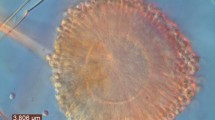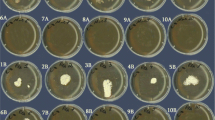Summary
Reconstituted skimmed milk powder containing the insecticides fenvalerate (benzene acetic acid, 4-chloro-α-1-methylcyano-3-phenoxyphenyl methyl ester), malathion (O,O-dimethyl-S-1, 2-bis-ethoxycarbonyl ethyl phosphorothioate) and DDT (2,2-bis-p-chlorophenyl-1,1,1-trichloroethane) in different concentrations (0, 50,100 and 200 ppm) was separately inoculated withStreptococcus lactis subsp.diacetilactis andLeuconostoc cremoris and incubated at 30°C for 120 h. Fenvalerate was more inhibitory towardsL. cremoris than other insecticides. Malathion strongly inhibited growth ofS. diacetilactis. Fenvalerate inhibited acid production byS. diacetilactis, but had no effect on acid production byL. cremoris. S. diacetilactis was in general more sensitive to all insecticides studied thanL. cremoris. S. diacetilactis produced more acidity and less acetaldehyde than those produced byL. cremoris whether in the presence or absence of insecticide.
Résumé
On a inoculé du lait écrémé, reconstitué à partir de poudre, contenant les insecticides fenvalerate (ester méthylique de l'acide 4-chloro-α-1-methylcyano-3-phenoxyphenyl benzene acétique), malathion (O,O-diméthyl-S-1,2-bis-éthoxycarbonyl éthyl phosphorothioate) et DDT (2,2-bis-p-chlorophenyl-1,1,1-trichloroéthane) à différentes concentrations (0, 50, 100 et 200 ppm), par leStreptococcus lactis, subsp.diacetilactis ou par leLeuconostoc cremoris. Après incubation à 30°C pendant 120 h, le fenvalerate s'est révélé plus inhibiteur duL. cremoris que les autres insecticides. Le malathion inhibe fortement la croissance deS. diacetilactis. Le fenvalerate inhibe l'acidogénèse parS. diacetilactis mais n'a aucun effet sur l'acidogénèse deL. cremoris. S. diacetilactis est en général plus sensible à tous les insecticides étudiés queL. cremoris. S. diacetilactis est plus acidogène et produit moins d'acétaldehyde que ne le faitL. cremoris que ce soit en présence ou en absence d'insecticide.
Similar content being viewed by others
References
Abdou, S. M., Abdel-Gawaad, A. A., Abo-El-Amaiem, E. &El-Alfy A. A. (1983) Effect of some organochlorine insecticides on some species of bacteria used in the dairy industry.Egyptian Journal of Dairy Science 11, 205–213.
American Public Health Association (1978) Standard methods for the examination of dairy products.A.P.H.A. 1970, Broadway, New York, USA.
Dean, D. D. &Patten, M. M. V. (1971) Effect of malathion and trichlorofon on growth and morphology of lactic culture organisms.Journal of Milk and Food Technology 34, 16–22.
Downey, W. K. (1972) Pesticide residues in milk and milk products.Annual Bulletin, Part II. pp. 45–47. International Dairy Federation, Bruxelles, Belgium.
Frank, R., Braun, H. E., Sirons, G. H., Rasper, J. &Ward, G. G. (1985) Organochlorine and organophosphorous insecticides and industrial pollutants in the milk supplies of Ontario, 1983.Journal of Food Protection 48, 499–504.
Hesse, V., Gabrio, T., Kirst, E. &Plenert (1981) Studies on the contamination of human milk, cow's milk and butter with chlorinated hydrocarbon compounds in the GDR.Kinderarztliche Praxis 49, 292–308.
Kim, S. C. (1970) Relationship between some insecticides and lactic culture organisms in milk.Sciences and Engineering 30, 4893.
Lauro, F. D. I., Fadini, L., Montesissa, C. &Pompa, G. (1984) Organochlorine pesticide residues in imported cow's milk.Attidella Societa Italiano delle Scienze Veterinarie 37, 255–258.
Lee, G. J. &Jago, G. R. (1969) Methods for the estimation of acetaldehyde in cultured dairy products.Australian Journal Dairy Technology 24, 181.
Ling, E. R. (1963)A textbook of Dairy Chemistry, Vol. II. Chapman and Hall, London.
Lucisano, A., Pesino, L., Mandici, M. &Maranelli, A. (1982) Chlorinated insecticide residues and polychlorinated biphenyls in milk products in Campania and Molise.Pharmacologie et Toxicologie Veterinaries 8, 167–168.
Luck, H. (1983) Pesticides in milk and dairy products.Journal of Dairy Technology 15, 75–79.
Man, J. C., Rogsa, M. &Sharpe, M. E. (1960) A medium for the cultivation of lactobacilli.Journal of Applied Bacteriology 23, 130–135.
Renner, E. (1981) InMathematic-Statistic Methods in the Practical Using, 2nd edn. Poul Parye Publishers, Berlin and Hamburg.
Sandford, M. L. &Langlois, B. E. (1976) Effect of organochlorine pesticides on growth and biological activities of bacterial species important to dairy food industry.Journal of Milk and Food Technology 39, 90–94.
Steel, R. G. D. &Torrie, J. H. (1960)Principles and Procedures of Statistics. McGraw-Hill Book Company, New York.
Author information
Authors and Affiliations
Rights and permissions
About this article
Cite this article
Hofi, A.A., Fayed, A.E., Arab, A.A.K.A. et al. Influence of insecticide residues on growth and activity ofStreptococcus diacetilactis andLeuconostoc cremoris . World J Microbiol Biotechnol 5, 181–186 (1989). https://doi.org/10.1007/BF01741841
Received:
Accepted:
Issue Date:
DOI: https://doi.org/10.1007/BF01741841




